Land Snails

Photo(s): Vertigo lilljeborgi vinlandica, Portage Lake, Aroostook County, Maine. Image © Jeffrey C. Nekola.
Click photo(s) to enlarge.
Vertigo (Alaea) lilljeborgi vinlandica Nekola et. al., in press
Family: Vertiginidae
Identification
Height: 1.8-2.4 mm
Width: 1.2-1.5 mm
Whorls: 5
The shells of V. lilljeborgi vinlandica are at best only weakly differentiated from V. lilljeborgi of boreal Eurasia, having perhaps a slightly more malleate surface sculpture and proportionally smaller aperture. This entity is much more readily distinguished by its genetics, however, and clearly represents a long-term North American isolate (Nekola et al., in press). This subspecies is quite similar to various eastern North American races of V. ovata, in particular a distinct New England coastal form similarly restricted to highly acid wetlands. Vertigo l. vinlandica is most easily distinguished from that entity by its proportionally smaller aperture and much less flared apertural margin. Vertigo l. vinlandica can also be distinguished from V. perryi, which also inhabits highly acidic northeastern North American wetlands by possessing a considerably larger shell with more prominent lamellae development.
Ecology
The four known stations for this subspecies all represent moderately to highly acid fens with significant graminoid ground cover (Nekola et al., in press). Type Locality: Vertigo lilljeborgi vinlandica, Portage Lake, Aroostook County, Maine, U.S.A.
Taxonomy
There are no synonyms.
Distribution
This subspecies ranges from northern Maine to the central Québec-Labrador border (Nekola et al., in press). Given the frequent occurrence of its acid wetland habitat in northeastern maritime boreal North America, it is to be expected across eastern Québec, Labrador, Newfoundland, and the maritime provinces of Canada. It is likely that the Ungava Bay record of “V. ovata” reported by Pilsbry (1948) actually represents V. l. vinlandica, as V. ovata is otherwise not known from north of the Gulf of St. Lawrence.
Conservation
Because this species has only been recently described, it has not yet been ranked by NatureServe. Given that it is currently known only from one site in northern Maine and three sites in the vicinity of Schefferville, Québec, a G1 ranking might appear warranted. However, because of its extensive documented range and the commonness of acid wetlands within the region, it is likely that once region-wide surveys have been conducted a G4G5 rank may be found to be more appropriate.
Jeff Nekola 9/2017
Range Map (click to enlarge)


